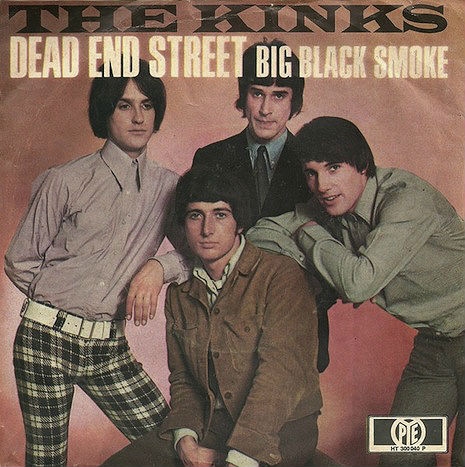
I was thumbing through The Rolling Stone Book of Rock Video the other day when I came across a section near the end of the book in which the author, Michael Shore, isolates “Rock Video’s Hot 100.” This book was published in 1984, so the list is heavy on DEVO, Duran Duran, ABC, The Cars, and so forth. But before he gets to that list, Shore indulges in a modicum of throat-clearing, isolating fourteen videos from 1966-1979 to define the prehistory (i.e., pre-MTV) of rock video.
The first video Shore mentions is The Kinks’ “Dead End Street,” from 1966, which apparently did something novel for the time: it wasn’t just a straight-up lip sync performance, there was a concept and a narrative. (The Who’s “Happy Jack,” also 1966, is mentioned as well. I don’t know which video came first, but “Dead End Street” was released as a single a couple of weeks before “Happy Jack.” Come to think of it, “Happy Jack” and “Dead End Street” are awfully similar, considered solely as promo films.)
True to The Kinks’ undying interest in the antiquated past of the United Kingdom, both song and video for “Dead End Street” come about as close to Dickens as is credible for a charting rock band. In the black-and-white video, the Kinks play pallbearers tasked with delivering a coffin to a widow in one of London’s ramshackle slums. The widow, played by Ray Davies, is looking to evade her malign landlord, a pint-sized chap in a bowler who picks his nose. The widow is reluctant to leave her flat, and the landlord decides to wait it out. The pallbearers leave with the coffin, but eventually the corpse, wearing nightclothes and a nightcap, jumps out of the coffin and scampers down the street, with the pallbearers giving chase. The reanimated fellow vanishes in a bit of movie magic reminiscent of Georges Meliès, to the astonishment of the baffled pallbearers.
The invocation of Meliès is far from an accident—the entire video is redolent of the melodrama of the silents, particularly the closeups of Davies as the widow. The video also includes two montages of stills with haunting photographs of impoverished British folks in the slums—to Davies, it was this focus on Britain’s poverty that made the video unacceptable to the BBC.
In Ray Davies: Not Like Everybody Else, Thomas M. Kitts lends some insight into the creation of the video as well as its reception:
The Kinks wanted to do something different to promote “Dead End Street.” Tired of the hackneyed lip-sync performance of Top of the Pops, Davies drew on his interest in film and his college experiences with Paul O’Dell to develop a promotional film, which Davies expected to air on British television.
-snip-
Unfortunately, after its screening, this remarkable three-and-one-half-minute film was banned by the BBC for being distasteful. With minimal controversy, the BBC could allude to the darkly humorous treatment of widows, pallbearers, coffins, and corpses. Perhaps, however, Davies surmised the true reason for the ban: “It showed slums and poverty and so they wouldn’t run it. I guess they prefer films about running around in parks, jumping over chairs.”
I assume that last line is a jab at The Beatles, but I don’t know for sure.
Any argument about the first conceptual music video will run aground on the endless prior instances one could care to name. Surely the list of possible candidates is long indeed. But for my money, there are few exemplars from the rock era that qualify as richly as the one The Kinks made for “Dead End Street.”
Previously on Dangerous Minds:
The Kinks ‘You Really Got Me’: kinky Barbie version
The Kinks perform ‘Father Christmas’ on German TV, 1977